The Samsung 960 Pro (2TB) SSD Review
by Billy Tallis on October 18, 2016 10:00 AM ESTSequential Read Performance
The sequential read test requests 128kB blocks and tests queue depths ranging from 1 to 32. The queue depth is doubled every three minutes, for a total test duration of 18 minutes. The test spans the entire drive, and the drive is filled before the test begins. The primary score we report is an average of performances at queue depths 1, 2 and 4, as client usage typically consists mostly of low queue depth operations.
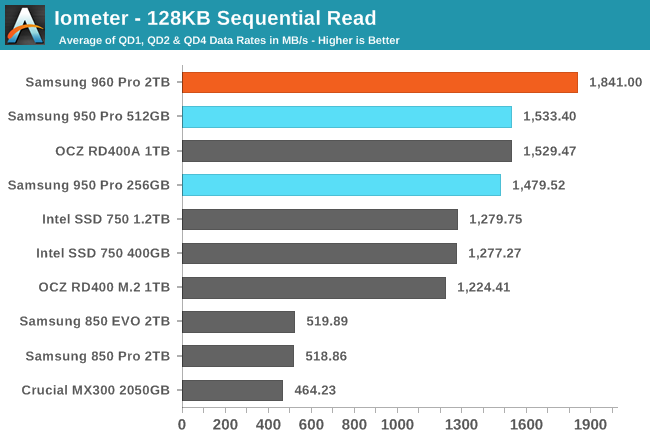
The 2TB 960 Pro's low queue depth sequential read speed is about 300MB/s faster than the 950 Pro, once again giving Samsung the clear lead in performance and showing that the 960 Pro is significantly better than the 950 Pro where thermal limits are a factor.
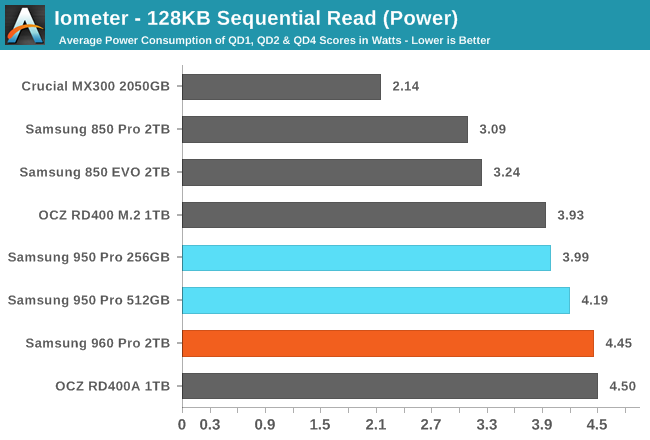
The 960 Pro consumes more power than its predecessors, but given the high performance it is the most efficient drive for this workload.
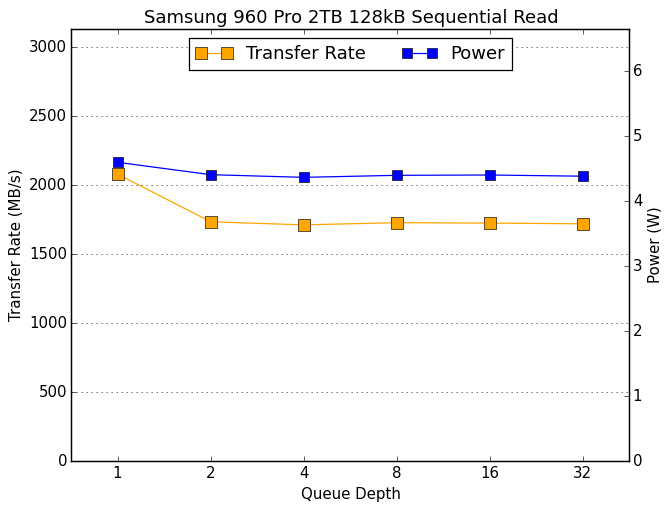 |
|||||||||
The slight drop in performance beyond QD1 indicates that the 960 Pro is still thermally limited for most of this test, and that like the 950 Pro it may perform much better with a heatsink.
Sequential Write Performance
The sequential write test writes 128kB blocks and tests queue depths ranging from 1 to 32. The queue depth is doubled every three minutes, for a total test duration of 18 minutes. The test spans the entire drive, and the drive is filled before the test begins. The primary score we report is an average of performances at queue depths 1, 2 and 4, as client usage typically consists mostly of low queue depth operations.
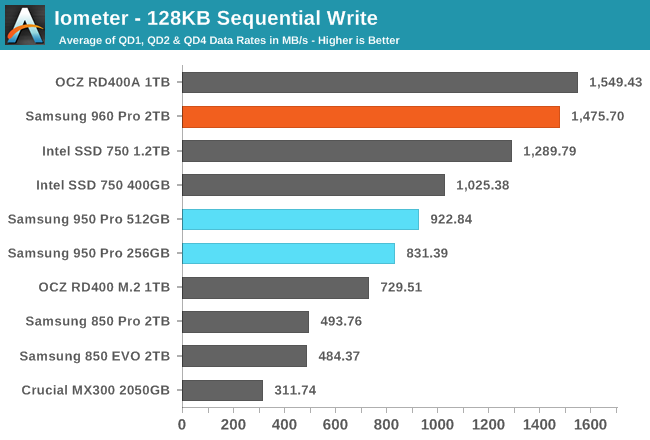
Thermals are an even bigger factor for the sequential write test than for sequential reads. The 960 Pro is 60% faster than the next fastest M.2 SSD and almost catches up to the RD400A with its thermal pad behind the controller allowing it to use its adapter card as a heatsink.
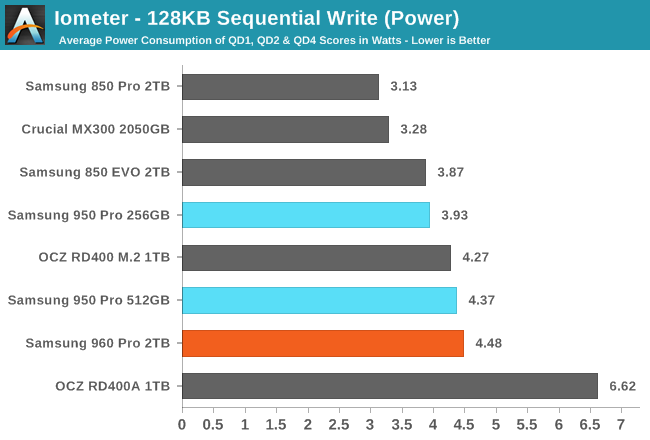
The 960 Pro's power consumption is only slightly higher than its M.2 competitors and far less than the RD400A. Given the performance, this makes the 960 Pro by far the most efficient SSD on this test, with about 30% higher performance per watt than the next most efficient drive.
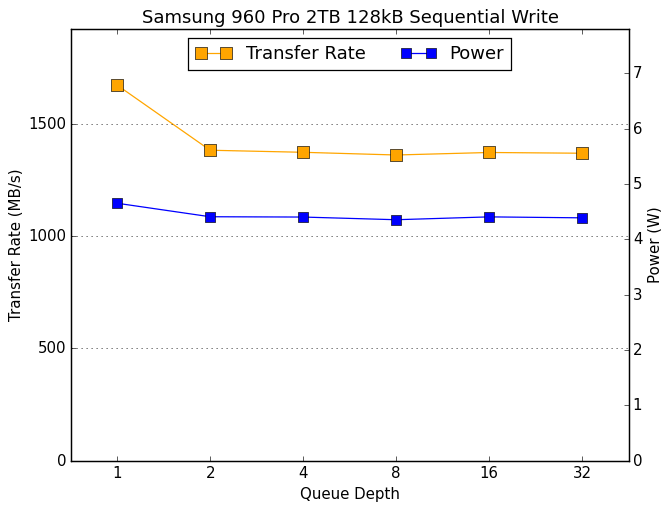 |
|||||||||
The QD1 performance of the 960 Pro is substantially higher than during the rest of the test where the drive is continuously thermally limited. The power consumption is only slightly higher at QD1 as the drive is able to spend a bit more power before its temperature gets up to the limit, then the drive reaches equilibrium at around 4.4W.










72 Comments
View All Comments
Billy Tallis - Tuesday, October 18, 2016 - link
The Intel 600p is very high on my to-do list. Since it's also using the Microsoft NVMe driver I want to run it through some more tests before publishing the review, but it should be done before I get the 960 EVO.WatcherCK - Tuesday, October 18, 2016 - link
Curious about the operating temperatures of the drive, Im guessing that Destroyer gave it a good thermal workout :) Puget Systems have done some testing on the effect of adding cooling to M2 SSDs:https://www.pugetsystems.com/labs/articles/Samsung...
Aquacomputer also make a PCIe Riser card equipped waterblock for M2 drives for those who want to water cool their SSD, the kryoM.2
Does anyone know if moving an M2 drive to a riser card improves cooling for the drive? I would think there is a little bit of improvement bringing the drive off the surface of the motherboard... How if at all is everyone keeping their motherboard mounted SSDs cool?
BurntMyBacon - Wednesday, October 19, 2016 - link
@WatcherCKYes, moving an M.2 drive to a riser card improves cooling (at least in my system). I checked temperatures mounted on my motherboard with a spot cooler directly on the 950Pro. I then compared it against mounting on a Silverstone ECM20 and an Asus Hyper M.2 X4 Mini (no spot cooler). If you are able to direct good airflow to the riser card, as I was, the Asus riser card is significantly cooler even though it had no spot cooler. If you use a thermal pad on the back of the M.2 drive on the Silverstone EMC20, it may in fact do even better than the Asus, but it my system, the larger standoffs allowed more air to flow behind the M.2 drive on the Asus solution. In any case, I can't seem to induce thermal throttling on my 950Pro in my setup regardless of how hard I try. Again, it will depend on how much airflow you can deliver it.
Gradius2 - Tuesday, October 18, 2016 - link
Those SSDs suffering from HEAT. If you don't put a forced cooling on them, it will DEGRADE the speed no matter what! This is why you won't see much than 3GB/s !iwod - Wednesday, October 19, 2016 - link
Where are these performance heading. Where Do we need to go. The destroyers and heavy definitely dont represent 95% of the consumer users usage. Do we need more higher Random Q1 Read Write? Or do we need higher Seq Read Write? If so then we dont need our firmware and powerful CPU core for QD32. Will that save cost? Why are we still within the 5W power usage? When can we get those dropped down to 2W or less.zodiacfml - Wednesday, October 19, 2016 - link
blazing fast. i will not be able to make useod this speed except for W10 upgradesprofdre - Monday, October 24, 2016 - link
@ Billy Talis: Would it be possible to test on another mainboard? There seems to be a clear bandwidth issue for sequential transfers, as other tech sites as https://www.computerbase.de/2016-10/samsung-ssd-96... achieved almost 3400 MB/s in CrystalDiskMark for the 512 GB model. At first they struggled to reach more than 3100 MB/s. (Samsung values were achieved with CrystalDiskMark according to computerbase).calbear88 - Tuesday, November 15, 2016 - link
Great table in the article summarizing the different Samsung NAND technologies. Here's a summary of the different types of NAND and which products they were in.27nm MLC 830 PM830
21nm MLC 840 pro
21nm TLC 840
19nm MLC XP941
19nm TLC 840 Evo
16nm MLC SM951
16nm TLC 750 Evo PM951
32 layer 86bit v-NAND MLC 850 Pro
32 layer 128bit v-NAND TLC 850 Evo
32 layer 128bit v-NAND MLC 950 Pro
48 layer 128bit v-NAND MLC 960 Pro SM961
48 layer 128bit v-NAND TLC 960 Evo PM961
Meteor2 - Wednesday, November 23, 2016 - link
How is new dies and an entirely new controller 'just a generational refresh of the 950 Pro', from any angle?anaconda1 - Monday, February 13, 2017 - link
The Samsung 2.1 driver has DPC latency issues on my end. I am usign a Samsung 960 500GB Evo nvme and using it with the Native Microsoft Driver (Windows 10 with latest updates installed) or the Samsung 2.0 driver, all is ok, DPC latency reports are fine - Latencymon and latency checker both report trouble free operation. However, installing the 2.1 driver, both Latencymon and dpc latency checker report problems with storport.sys and problems with DPC. Rolling back the driver from the Samsung 2.1 to the Microsoft or the Samsung 2.0, all goes back to normal